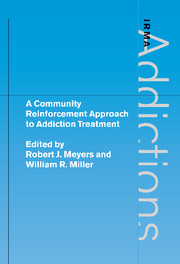Book contents
- Frontmatter
- Contents
- List of contributors
- Preface
- Acknowledgments
- 1 Developing the Community Reinforcement Approach
- 2 Practice and Promise: The Azrin Studies
- 3 The Treatment
- 4 A Comparison of CRA and Traditional Approaches
- 5 Community Reinforcement and Traditional Approaches: Findings of a Controlled Trial
- 6 CRA with the Homeless
- 7 CRA and Treatment of Cocaine and Opioid Dependence
- 8 Community Reinforcement and Family Training (CRAFT)
- 9 Summary and Reflections
- References
- Index
2 - Practice and Promise: The Azrin Studies
Published online by Cambridge University Press: 05 August 2012
- Frontmatter
- Contents
- List of contributors
- Preface
- Acknowledgments
- 1 Developing the Community Reinforcement Approach
- 2 Practice and Promise: The Azrin Studies
- 3 The Treatment
- 4 A Comparison of CRA and Traditional Approaches
- 5 Community Reinforcement and Traditional Approaches: Findings of a Controlled Trial
- 6 CRA with the Homeless
- 7 CRA and Treatment of Cocaine and Opioid Dependence
- 8 Community Reinforcement and Family Training (CRAFT)
- 9 Summary and Reflections
- References
- Index
Summary
In the early 1970s, George Hunt and his advisor, Nathan Azrin, developed a theory for describing the etiology and maintenance of alcohol problems and a therapy approach for addressing how to treat them. Based on learning theory, and in particular on the operant approach described by Skinner (1938), their Community Reinforcement Approach (CRA) for the treatment of alcohol dependence stressed the interaction between a person's behavior and the environment. Until this time, most alcohol treatment programs had focused on the treatment of the individual and had greatly ignored the importance of the individual's social environment. Hunt and Azrin proposed that the etiology of alcohol problems was influenced by patterns of positive and negative reinforcement. Specifically, drinking was believed to be maintained by the reinforcing properties of its subjective effects (e.g., pleasant and relaxing feelings), physical sensations (e.g., taste), social rewards, and dependence-inducing qualities. These sources of reinforcement could possibly maintain drinking indefinitely, depending on the accumulated strength of these factors for an individual. However, Hunt and Azrin theorized that those with alcohol problems might be deterred from drinking when use of alcohol interfered with other sources of satisfaction and positive reinforcement in their environment. They predicted that drinking could be reduced if reinforcers for not drinking, such as a better interpersonal relationship or satisfying employment, were maximized, frequent, and contingent upon not drinking alcohol. To accomplish this goal, CRA attempted to rearrange these contingencies such that sober behavior was more rewarding than drinking behavior.
Keywords
- Type
- Chapter
- Information
- Publisher: Cambridge University PressPrint publication year: 2001
- 3
- Cited by



